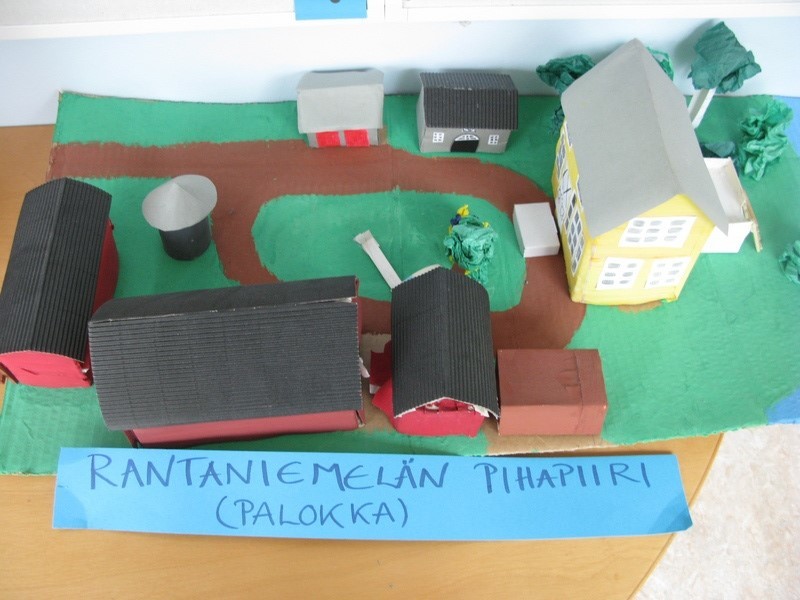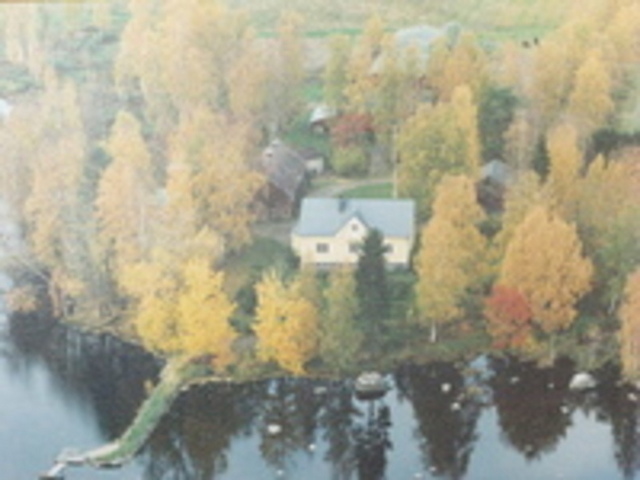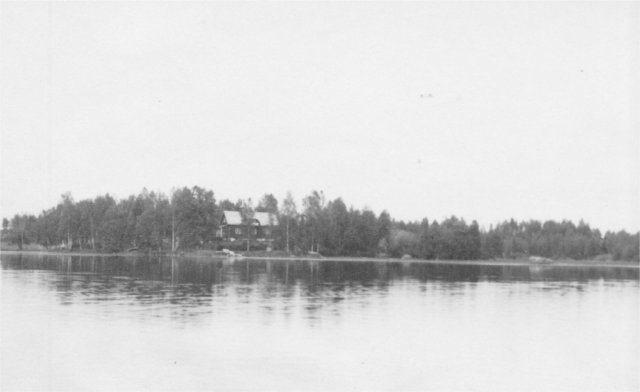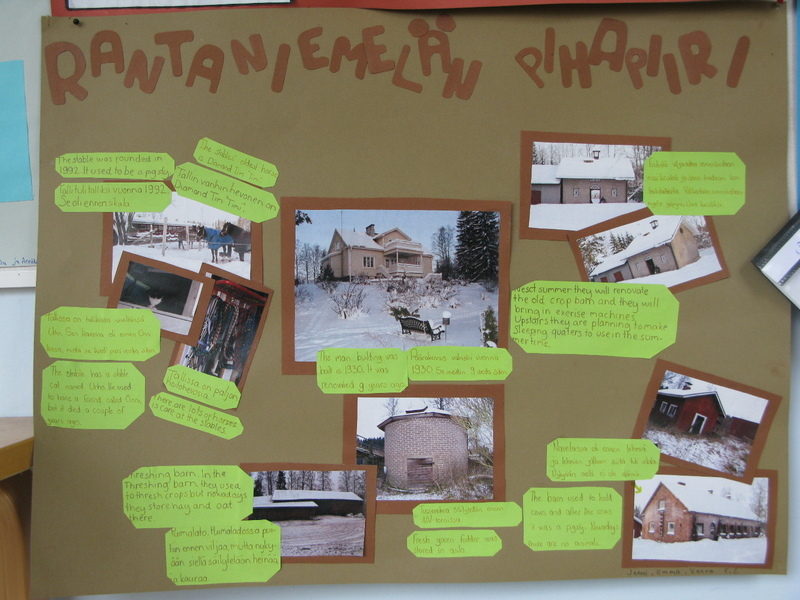Anne 5c
Anne 5c
Rantaniemelän pihapiiri oppilaiden tekemänä

Rantaniemelän pihapiiri oppilaiden tekemänä
Rantaniemelän pihapiiri

RANTANIEMELÄN MAATILA
Rantaniemelän maatilan historia alkaa 1920-luvulta, jonka loppupuolella isoisäni Jussi Vihtori Niemelä osti Mankolan tilasta lohkotun vajaan 40 hehtaarin uudistilan. Peltoa raivattiin aluksi noin 10 hehtaaria. Päärakennuksen hirret ajettiin jään yli hevosilla Tuomiojärven pohjois-päässä sijaitsevalle niemelle talvella 1928. Rakentaminen ei tuohon aikaan tapahtunut het-kessä. Päärakennus, punatiilinen navetta, harmaatiilinen vilja-aitta ja puimala valmistuivat asuttavaksi ja käytettäväksi vasta 1932. Tilan varsinainen perustamisvuosi on siten 1932.
Tilalla harjoitettiin ajan tapaan monialaista maataloutta viljelemällä mm. ruista, ohraa, kauraa, monenlaisia kasviksia sekä tietysti heinää lypsykarjaa varten. Tilalla oli aina 1950-luvulle asti myös lampaita ja esimerkiksi hanhia. Sotien jälkeen 1940-luvun loppupuolella tilalle rakennet-tiin kanala ja AIV-torni tuorerehua varten. Erillistä tallirakennusta ei ollut, mutta navetan ja kanalan yhteydessä asusti yleensä 2-3 työhevosta. Samoihin aikoihin tila siirtyi isälleni Veik-ko Niemelälle. Huolimatta siitä, että tila oli siihen aikaankin korkeintaan keskikokoinen, tilalla työskenteli ympärivuoden keskimäärin kolme ulkopuolista työntekijää. Äitini oli töissä tilan ulkopuolella opettajana Keski-Palokan koulussa.
!960-luvun puolivälissä tilan tuotantosuunta muutettiin täysin luopumalla lypsykarjasta ja siir-tymällä sikatalouteen. Noin 200 sikaa kasvatettiin aluksi entisessä navetassa ja muutaman kilometrin päässä sijaitsevassa vuokrasikalassa, kunnes tilan yhteyteen rakennettiin varsi-nainen sikalarakennus vuonna 1971. Aluksi sikala toimi sekä emakkosikalana että lihasikala-na, mutta jo 1970-luvun puolivälistä lahtien pelkästään lihasikalana. Sikalan toiminta perustui alusta lähtien siihen, että siat ruokittiin noin 80 prosenttisesti jäteruualla, jota hankittiin Jyväs-kylän alueen sairaaloista, kouluista, ravintoloista ja jossain myös taloyhtiöistä. Sikojen ruok-kiminen pelkästään viljalla eli lähinnä ohralla olisi tullut huomattavasti kalliimmaksi. Pilaantu-maton ja hyvä sekaruoka tuntui myös maittavan sioille parhaiten.
Tilan tähän mennessä viimeinen suuri muutos tapahtui vuosina 1989-1992. Tilan toimintaa uhkasi lähestyvä taajama-asutus ja etenkin Suomen hakeutuminen EU:n jäseneksi. Asutuk-sen lähestyminen tilanteeseen, jossa Jyväskylän maalaiskunta osti pääosan eli 25 hehtaaria tilasta. Vielä olennaisempaa oli se, että Suomen sopeutuessa Euroopan yhteisöön esimer-kiksi sianlihan tuottajahinta putosi nopeasti kolmannekseen entisestään.
Viimeiset siat lähtivät teurastamoon keväällä 1992, jolloin saman tien aloitettiin uusimman sikalarakennus saneeraaminen 10 hevosen talliksi. Tilan ahtauden ja vähäisten ajomahdolli-suuksien vuoksi talli päätettiin perustaa alusta lähtien ratsutalliksi. !990-luvun puoliväliin asti tilalla oli vielä satakunta kanaa lähinnä isäni harrastuksena kotitarvetta ja naapureita varten.
Ratsutallia pidettiin aina 2010 asti pelkästään harrastuksena ilman ansaintatarkoitusta. Vuoden 2010 alusta lähtien tallitilat 13 hevoselle ja heinä- ja viljavarastona toimiva puimala on vuokrattu veljeni tyttärelle ja hänen miehelleen, jotka ovat ryhtyneet hoitamaan tallia yritysmäisesti. Ratsutilan käytössä on tilan vielä omistamat 3 hehtaaria laidunmaata ja saman verran vuokramaata.
The main building was built in 1931 by the lake Tuomiojarvi.

RANTANIEMELÄ FARM
Rantaniemelä farm’s history begins in the late 1920’s when my grandfather Jussi Vihtori Niemelä bought a 40 hectare segment from Mankola. 10 hectares of fields were first cleared. The timber for the main building was pulled by horses over the frozen Tuomio Lake in 1928. Building at this time did not happen very quickly. The grain building, a red brick barn, a grey brick grain shed and a grain barn were not finished and ready to be lived in and used until 1932. So the farm was founded in 1932.
Many types of agriculture were grown on the farm. Rye, barley, oat and different vegetables and of course hay for the cattle were harvested. Until the 1950’s there were also sheep and geese on the farm. After the war, in the 1940’s, a hen house and a silo for fresh fodder were built on the farm. There wasn’t a separate stable but in conjunction with the barn and hen house usually lived 2-3 work horses. Around this time the farm was passed down to my father Veikko Niemelä. Despite the fact that the farm was only a medium sized farm, there were on average 3 outside workers around the year. My mother worked as a teacher at Keski-Palokka School.
Midway through the 1960’s the farm’s production was changed from cattle to pigs. At first about 200 pigs were raised in the old barn and in a rental pig sty a few kilometres away, until an actual piggery was built on the farm in 1971. In the beginning the piggery functioned as a sow piggery and a meat piggery but from the mid 1970’s only as a meat piggery. From the beginning the piggery’s functioning was based on the pigs being fed on waste foods which were supplied from Jyväskylä’s hospitals, schools, restaurants and some building corporations. It would have been much more expensive feeding the pigs grains especially barley. Unspoiled and mixed foods also seemed to go well with the pigs.
The last big change done on the farm happened in the years 1989-1992. The nearing residential area and also Finland’s application to be a member of the EU were a threat to the farms operation. The approaching residential area situation led to Jyväskylä County buying a majority of the farm, about 25 hectares. What’s even more essential is that while Finland was adjusting to being part of the European community, the production price of pig meat fell quickly to a third of the original price.
The last of the pigs went to the slaughter house in 1992, when began the remodelling of the pig sty into a stable. The lack of space and riding possibilities led to making the farm into a stud farm. To the mid 1990’s there were still about a hundred chickens mainly as a hobby for the family and neighbours.
The horse stables were kept to the year 2010 just as a hobby without any money gain purpose. From the beginning of 2010 the stables for 13 horses and barn for hay and grains were rented to my niece and her husband who have begun to run the stables businesswise. The stables have 3 hectares of grazing land and the same amount of rental land from the farm.
The main building in the fourties.



Rantaniemelän pihapiiri oppilaiden tekemänä
Rantaniemelän pihapiiri

RANTANIEMELÄN MAATILA
Rantaniemelän maatilan historia alkaa 1920-luvulta, jonka loppupuolella isoisäni Jussi Vihtori Niemelä osti Mankolan tilasta lohkotun vajaan 40 hehtaarin uudistilan. Peltoa raivattiin aluksi noin 10 hehtaaria. Päärakennuksen hirret ajettiin jään yli hevosilla Tuomiojärven pohjois-päässä sijaitsevalle niemelle talvella 1928. Rakentaminen ei tuohon aikaan tapahtunut het-kessä. Päärakennus, punatiilinen navetta, harmaatiilinen vilja-aitta ja puimala valmistuivat asuttavaksi ja käytettäväksi vasta 1932. Tilan varsinainen perustamisvuosi on siten 1932.
Tilalla harjoitettiin ajan tapaan monialaista maataloutta viljelemällä mm. ruista, ohraa, kauraa, monenlaisia kasviksia sekä tietysti heinää lypsykarjaa varten. Tilalla oli aina 1950-luvulle asti myös lampaita ja esimerkiksi hanhia. Sotien jälkeen 1940-luvun loppupuolella tilalle rakennet-tiin kanala ja AIV-torni tuorerehua varten. Erillistä tallirakennusta ei ollut, mutta navetan ja kanalan yhteydessä asusti yleensä 2-3 työhevosta. Samoihin aikoihin tila siirtyi isälleni Veik-ko Niemelälle. Huolimatta siitä, että tila oli siihen aikaankin korkeintaan keskikokoinen, tilalla työskenteli ympärivuoden keskimäärin kolme ulkopuolista työntekijää. Äitini oli töissä tilan ulkopuolella opettajana Keski-Palokan koulussa.
!960-luvun puolivälissä tilan tuotantosuunta muutettiin täysin luopumalla lypsykarjasta ja siir-tymällä sikatalouteen. Noin 200 sikaa kasvatettiin aluksi entisessä navetassa ja muutaman kilometrin päässä sijaitsevassa vuokrasikalassa, kunnes tilan yhteyteen rakennettiin varsi-nainen sikalarakennus vuonna 1971. Aluksi sikala toimi sekä emakkosikalana että lihasikala-na, mutta jo 1970-luvun puolivälistä lahtien pelkästään lihasikalana. Sikalan toiminta perustui alusta lähtien siihen, että siat ruokittiin noin 80 prosenttisesti jäteruualla, jota hankittiin Jyväs-kylän alueen sairaaloista, kouluista, ravintoloista ja jossain myös taloyhtiöistä. Sikojen ruok-kiminen pelkästään viljalla eli lähinnä ohralla olisi tullut huomattavasti kalliimmaksi. Pilaantu-maton ja hyvä sekaruoka tuntui myös maittavan sioille parhaiten.
Tilan tähän mennessä viimeinen suuri muutos tapahtui vuosina 1989-1992. Tilan toimintaa uhkasi lähestyvä taajama-asutus ja etenkin Suomen hakeutuminen EU:n jäseneksi. Asutuk-sen lähestyminen tilanteeseen, jossa Jyväskylän maalaiskunta osti pääosan eli 25 hehtaaria tilasta. Vielä olennaisempaa oli se, että Suomen sopeutuessa Euroopan yhteisöön esimer-kiksi sianlihan tuottajahinta putosi nopeasti kolmannekseen entisestään.
Viimeiset siat lähtivät teurastamoon keväällä 1992, jolloin saman tien aloitettiin uusimman sikalarakennus saneeraaminen 10 hevosen talliksi. Tilan ahtauden ja vähäisten ajomahdolli-suuksien vuoksi talli päätettiin perustaa alusta lähtien ratsutalliksi. !990-luvun puoliväliin asti tilalla oli vielä satakunta kanaa lähinnä isäni harrastuksena kotitarvetta ja naapureita varten.
Ratsutallia pidettiin aina 2010 asti pelkästään harrastuksena ilman ansaintatarkoitusta. Vuoden 2010 alusta lähtien tallitilat 13 hevoselle ja heinä- ja viljavarastona toimiva puimala on vuokrattu veljeni tyttärelle ja hänen miehelleen, jotka ovat ryhtyneet hoitamaan tallia yritysmäisesti. Ratsutilan käytössä on tilan vielä omistamat 3 hehtaaria laidunmaata ja saman verran vuokramaata.
The main building was built in 1931 by the lake Tuomiojarvi.

RANTANIEMELÄ FARM
Rantaniemelä farm’s history begins in the late 1920’s when my grandfather Jussi Vihtori Niemelä bought a 40 hectare segment from Mankola. 10 hectares of fields were first cleared. The timber for the main building was pulled by horses over the frozen Tuomio Lake in 1928. Building at this time did not happen very quickly. The grain building, a red brick barn, a grey brick grain shed and a grain barn were not finished and ready to be lived in and used until 1932. So the farm was founded in 1932.
Many types of agriculture were grown on the farm. Rye, barley, oat and different vegetables and of course hay for the cattle were harvested. Until the 1950’s there were also sheep and geese on the farm. After the war, in the 1940’s, a hen house and a silo for fresh fodder were built on the farm. There wasn’t a separate stable but in conjunction with the barn and hen house usually lived 2-3 work horses. Around this time the farm was passed down to my father Veikko Niemelä. Despite the fact that the farm was only a medium sized farm, there were on average 3 outside workers around the year. My mother worked as a teacher at Keski-Palokka School.
Midway through the 1960’s the farm’s production was changed from cattle to pigs. At first about 200 pigs were raised in the old barn and in a rental pig sty a few kilometres away, until an actual piggery was built on the farm in 1971. In the beginning the piggery functioned as a sow piggery and a meat piggery but from the mid 1970’s only as a meat piggery. From the beginning the piggery’s functioning was based on the pigs being fed on waste foods which were supplied from Jyväskylä’s hospitals, schools, restaurants and some building corporations. It would have been much more expensive feeding the pigs grains especially barley. Unspoiled and mixed foods also seemed to go well with the pigs.
The last big change done on the farm happened in the years 1989-1992. The nearing residential area and also Finland’s application to be a member of the EU were a threat to the farms operation. The approaching residential area situation led to Jyväskylä County buying a majority of the farm, about 25 hectares. What’s even more essential is that while Finland was adjusting to being part of the European community, the production price of pig meat fell quickly to a third of the original price.
The last of the pigs went to the slaughter house in 1992, when began the remodelling of the pig sty into a stable. The lack of space and riding possibilities led to making the farm into a stud farm. To the mid 1990’s there were still about a hundred chickens mainly as a hobby for the family and neighbours.
The horse stables were kept to the year 2010 just as a hobby without any money gain purpose. From the beginning of 2010 the stables for 13 horses and barn for hay and grains were rented to my niece and her husband who have begun to run the stables businesswise. The stables have 3 hectares of grazing land and the same amount of rental land from the farm.
The main building in the fourties.

